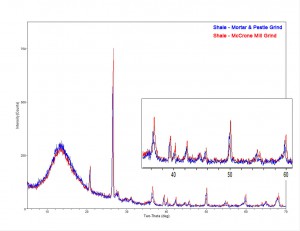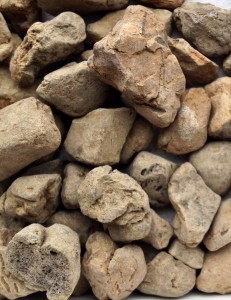Over the past 15 years, Barnett Shale has become a major resource for natural gas in Texas. Being located in the North Texas region, it is easy to see the boom of drilling rigs and wells popping up in the suburban and rural areas between Ft. Worth and Denton. Collaborations between Geologists at universities and major oil companies have put a large amount of research into characterizing shale. In 2001, Środoń et al. published a journal article in Clays and Clay Minerals that discussed the importance of sample preparation for sediments, such as shale, to be analyzed using X-ray diffraction.
Powder X-ray diffraction is the preferred and best technique to identify and quantify mineral compositions in geological materials such as rocks, sediments, and soils. Sample preparation and loading are two important factors for accurate quantitative XRD analysis using Rietveld refinement. Proper sample grinding and using a side-loader or backside loader are common practices to avoid preferred orientation. At Texray, we have a variety of sample holders for different applications, and we can even custom build holders for those random parts. However, in this study we wanted to see for ourselves the effect of sample grinding and particle size, and also we wanted to test out our new McCrone Micronizing Mill. We already knew what the results would be from experience and previous work by Środoń et al., 2001 and Klug and Alexander, 1974, but this was a fun experiment to try with shale.
The rocks (pictured above) were broken up into smaller pieces using a mortar and pestle, and then half was transferred to the McCrone mill for wet grinding and the other half we continued to grind manually using the mortar and pestle. By the way if you are running out of bench space in the laboratory and are looking for a mill, I highly recommend the McCrone Micronizing Mill because it takes up very the little space and it’s capable of grinding below 10 μm in less than 10 minutes. After grinding, we loaded the powder samples into a backside loader and analyzed them using a Bruker D5000 X-ray Diffractometer.

XRD pattern of Mortar & Pestle Ground Shale (blue) vs McCrone Mill Ground Shale (red)
In the XRD pattern shown above the main differences you will notice between the two grinding methods are peak intensities and a small 2-theta peak shift. Both of these differences are effects related to particle size distribution and sample loading. Wet grinding the shale in a McCrone Mill creates smaller uniform particles (~5μm), therefore when loading the sample into holders the powders pack easier and tighter creating a denser layer of material for the X-rays to penetrate, hence higher peak intensities compared to manual grinding. Sample preparation is one of the most important aspects to quantitative XRD because of preferred orientation and sample displacement. In order to reduce user error such as, induced preferred orientation, it is essential we learn from previous research and take the proper steps to prepare samples. The ICDD is a great source for free literature on applications involving XRD and XRF. We will be posting more discussions on sample preparation and applications in the future.

